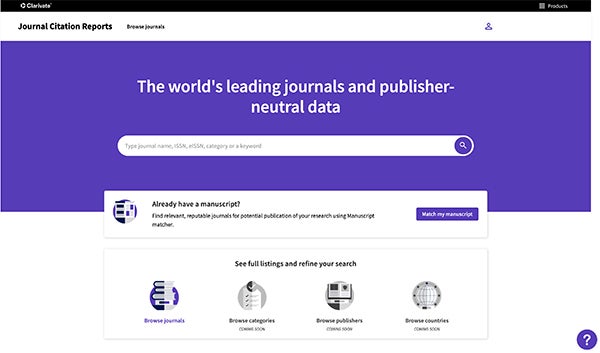This blog post is about the 2021 release of the Journal Citation Reports™. You can learn about Journal Citation Reports 2022 here.
This year’s release showcases expanded content, a new metric and a revamped user experience – delivering on our commitment to provide transparent, publisher-neutral journal intelligence to help the research community make better informed, more confident decisions.
For nearly 50 years publishers, institutions, funders and researchers have relied on unbiased data in the Journal Citation Reports (JCR)™ to identify and evaluate the world’s leading journals.
Today, we are proud to launch the 2021 edition of the JCR, celebrating the continued evolution in our rich array of journal intelligence metrics drawn from the 2020 data in the Web of Science Core Collection™. This year’s edition includes more than 20,000 journals from 113 countries across five continents and 254 research categories in the sciences, social sciences, arts and humanities.
Each year’s release helps the research community to evaluate the world’s high-quality academic journals using a range of indicators, descriptive data and visualizations. Academic publishers across the globe use the reports to evaluate the impact of their journals relative to their field and promote them to the research community; researchers rely on them when deciding where to submit their journals; and librarians draw on their insights when managing their collections.
We are proud of our rich heritage, and conscious of the important role we play in continuing to provide high-quality data the world can rely on. The carefully selected and structured data within the JCR allows the research community to make better informed, more confident decisions with transparent, publisher-neutral journal intelligence.
But we won’t stop there. The last year has reaffirmed that the pace of innovation is increasing more than ever, and the JCR is evolving to pave the way for future research that will change the world for the better.
New for 2021, we’re pleased to introduce:
- New expanded content: This year we’re adding over 70% more content to the JCR by including the Arts & Humanities Citation Index (AHCI)™ and the Emerging Sources Citation Index (ESCI)™. JCR coverage of journal literature will now reflect the full breadth of research covered in all the journals in the Web of Science Core Collection.
- New Journal Citation Indicator: This new field-normalized indicator provides a single journal-level metric that can be easily interpreted and compared across disciplines. The Journal Citation Indicator will be calculated for all journals in the Web of Science Core Collection – including those that do not have a Journal Impact Factor (JIF)™. Developed by the Institute for Scientific Information (ISI)™, it is designed to complement the JIF – the original and longstanding metric for journal evaluation – and other metrics currently used in the research community.
- New user experience: We redesigned the JCR user interface based on user feedback so the layered, rich data can be easily and intuitively explored and visualized. New graphics will improve the user experience with simpler, more direct searching while allowing a deeper look into the data. Dual access to the new and old platforms will be available through the end of 2021 so users will have time to become familiar with the new version.

- Early Access content: The expanded coverage in the 2021 JCR release will introduce Early Access articles, reflecting the earliest availability of new research as it appears in the ‘version of record’ prior to official publication.
Explore the key highlights from the 2021 Journal Citation Reports here. For more information, visit the Journal Citation Reports website to explore all available data, metrics and analysis, and follow #JCR2021 on social media.
Listen to episode 3 of the Ideas to Innovation podcast to learn more about what the 2021 JCR release means for publishers.






